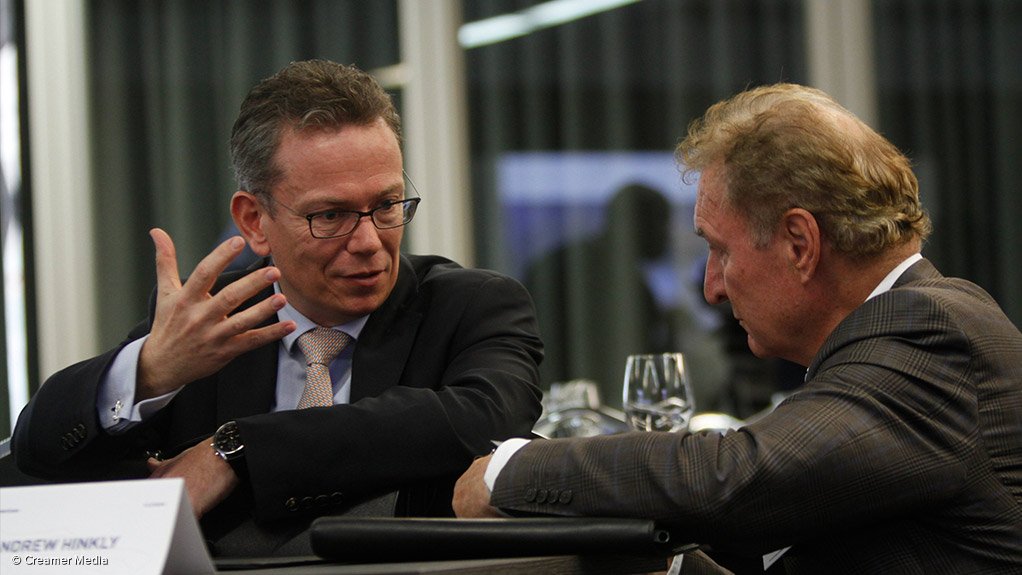JOHANNESBURG (miningweekly.com) - The Mogalakwena platinum mine lived up to its reputation of being the most profitable platinum group metals (PGM) mine on the planet when it gushed cash and elevated a modernising, community supporting, environment protecting, growth studying and fuel-cell marketing Anglo American Platinum (Amplats) well in the money.
The opencast platinum mine on the northern limb of the Bushveld Complex gushed R4-billion worth of free, unfettered operating cash flow, achieving a nigh 50% profit margin on a depressed platinum price of only $950/oz. (Also watch attached Creamer Media video).
It had an all-in sustaining cost of only $340/oz per platinum ounce sold in the 12 months to December 31.
From this mine that yields platinum, palladium, other PGMs and gold, Amplats received not only value but also volume as the mine lifted its production by 12% to nearly 1.1-million PGM ounces that included 464 000 oz of platinum, without any capital spend to speak of.
"Mogalakwena had an exceptional year," Amplats CEO Chris Griffith said of the mine that had the company's best earnings before interest, taxation, depreciation and amortisation (Ebitda) margin of 48% for 2017.
But nothing like that was achieved by the Amandelbult mine, Amplats' second key asset, which Griffith described to the mining analysts, fund managers and media that included Mining Weekly Online during the presentation of good 2017 financial results.
The transition resulted in Amandelbult's PGM production decreasing by 3% to 858 000 PGM ounces, but with its newly developed chrome plant coming to the party by generating almost half a billion rands worth of free cash on an output of 650 000 t of chrome, which contributed to Amandelbult's emerging with an Ebitda margin of 10% and R91-million worth of attributable free cash flow.
MODERNISATION
Low-profile board-and-pillar mechanised mining is being put through its paces at Twickenham.
"It's starting to look very exciting," Griffith told Mining Weekly Online.
Not expected to be implemented in the short term is also hard-rock cutting of PGM ore.
"We're seeing some really good progress. We think we're very close to being able to deploy some of that technology, not yet the cutting, but certainly the low-profile, mechanised equipment.
"It's something we're very excited about and it is one of the technologies we're thinking about for the Amandelbult 15 East Dropdown area - to deploy, even though it's in a steeper mining environment, some of this equipment," Griffith said, adding that conventional mining is not wanted for the next generation of expansion at Amandelbult and must incorporate many of the advances that have been progressed for many years.
More immediate shorter-term solutions have also been found for improving productivity and safety.
Modernised drilling technologies, safety nets and explosives have been introduced at Amandelbult, which although not revolutionary, were improving productivity and safety.
Many improvements were also being considered for implementation at the processing level, including different crushing, milling and sorting.
FUEL CELL DEMAND IN CHINA
Amplats executive head of marketing Andrew Hinkly said hydrogen refuelling stations were critical to the broader rollout of fuel cells, which use platinum.
Hinkly told Mining Weekly Online that steady progress was being seen across the traditional markets of Japan, US and Western Europe.
"What's been most pleasing to see is the adoption of fuel cell forklift trucks in the US market and investment of both Amazon and Walmart into hydrogen infrastructure associated with fuel cell trucks. That's been very positive in traditional markets.
"What's been dramatic is the increase in hydrogen interest and infrastructure investment in China. We now see the prospect of more hydrogen refuelling stations in the next three years in China than in the rest of the world combined. So, it's been quite a dramatic year driven largely by what's happening in China," Hinkly said in response to Mining Weekly Online.
He said that China's strategy related to fuel cells was linked to broader to the country's broader strategy of improving the environment, particularly in the cities.
The fuel cell strategy for cities was linked to delivery trucks and commercial vehicles, which he described as a "very thoughtful" approach to harness range, uptime and fast refuelling capability of the fuel cell.
This addressed the specific duty cycle of commercial trucks in cities.
"It's a very thoughtful strategy. It supports the over-arching ambition of improving air quality and this is evidenced in the way number of fuel cell vehicles being deployed and the associated infrastructure.
"It's really very impressive. It reminds me of what China has done with other technologies in the past, such as solar, wind and batteries, in fairness, as well. There are more battery electric vehicles in China than anywhere else in the world," Hinkly said.
China had, he added, a political and social need to address air quality, but in so doing, China had recognised that it could create an industry, and the country was willing to invest in that industry, which was bringing down costs.
"A nice virtuous system with a very admirable destination, which is better quality of air for the people living in cities in China," he said.
Electrification of the powertrain would not be uniform and depend much on the duty cycle of the vehicle.
COMMUNITY INVESTMENT
The community is also involved in the Amandelbult chrome plant and the community and the black economic empowerment partners received R140-million from the plant, R89-million of which was used to settle their debt and the interest and R51-million was distributed as a dividend.
Amplats' social investment totalled R295-million in 2017, when it completed eight schools, three healthcare and clinic projects and five social infrastructure projects.
ENVIRONMENTAL PROTECTION
The company cut greenhouse gas emissions by 8%, energy intensity by 5% and water use 1% and will be spending R2.5-billion on sulphur dioxide abatement projects at its smelters to achieve global best practice.
Management of both hazardous and non-hazardous waste to landfill sites has improved by 39% year-on-year, with programmes and projects in place to achieve a zero-waste-to-landfill ambition.
Overall, Amplats generated R2.4-billion in free cash flow generated from its operations, doubled return on capital employed to 18% and reintroduced a cash dividend for the first time in seven years.
Productivity rose by 16% year-on year and has soared by 58% since 2012.
The company now has 70% of its production in the first half of the cost curve.
"We're more efficient, we're more competitive and we're generating better returns," said Griffith.
PGM production was five-million ounces in the 12 months to December 31, up on the 4.97-million of 2016, net debt cut to R1.8-billion from R7.3-billion and a dividend of R3.49 a share declared compared with none since 2011.
Griffith forecast that platinum would likely be in a small surplus again, with demand exceeded by overall supply, but that forecasts suggested that the three major PGMs - platinum, palladium and rhodium - should collectively be in deficit again in 2018.
The outlook for palladium was positive once more with the number of vehicles produced likely to grow.
PGMs production guidance for 2018 was put at between 4.75-million ounces and five-million ounces and for platinum between 2.3-million ounces and 2.4-million ounces.
Rising vehicle production volumes and a healthy global economy should drive higher demand, while primary mine production is likely to be unchanged.
Amplats FD Ian Botha said in response to a balance sheet question that the first priority of the company was to restore strong balance sheet, which the company regarded as a true competitive advantage.
"We can see that the market is rewarding strong balance sheets," Botha said, adding that the company had confidence in underlying cash generation.
From a capital allocation perspective, the company's next priorities were around funding growth projects.
Botha said that the company had attractive growth potential at the Mogalakwena and Der Brochen mines, where growth decisions would be taken at the end of 2019, along with the declaration of additional dividends above its base dividend.
Griffith said in response to a currency impact question by Mining Weekly Online that the company had demonstrated that it was able to manage the business for the pricing environment that it had.
"What we haven't done is relied on the hope of a weaker rand, or whatever the case might be," the CEO of the JSE-listed company said.
What was traditionally seen, though, was that a strengthening rand was accompanied by a strengthening collective basket prices for the metals.
"That's exactly what we're actually seeing at the moment. We're seeing a dollar basket price strengthening and although we've seen only a marginal uplift in the rand basket price. But the fact is we will manage the business and if the prices in dollar terms are weak and the rand is strong, that means we'll have a lower rand basket price, so we'll have to manage the business for that," Griffith told Mining Weekly Online.
The price being obtained as a basket, he said, was between R26 400/oz and R26 600/oz, slightly up the price 2017.
China continued to be a very strong demand offtake for the industrial uses of PGMs, which was a third of overall platinum demand.
"Industrial grew very strongly at 6% last year. So when you see some of those very negative headline messages that say, look, Western Europe diesel is down therefore the whole demand basket is down, actually that is not entirely the case and we were only marginally down for auto last year, but we had very strong growth in industrial and a lot of that growth is coming from China.
Total PGM production was up 1% despite removing loss-making production from Bokoni and Maseve as well as the unplanned stoppage at Mototolo to complete remedial work on the tailings facility
EMAIL THIS ARTICLE SAVE THIS ARTICLE ARTICLE ENQUIRY
To subscribe email subscriptions@creamermedia.co.za or click here
To advertise email advertising@creamermedia.co.za or click here












